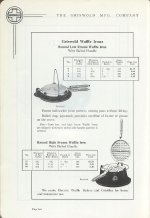-
Amazon Black Friday Week/Cyber Monday Deal Event, running November 21 through Monday, December 2, 2024. Please consider using the CIC link to shop this Amazon event. Or go directly to Black Friday Deals or Cyber Monday Deals. Not a Prime member? Try a Prime 30-day Free Trial Membership.
-
If a web search for the answer to your cast iron cookware question has brought you directly to this forum, the information you seek may be covered in one of the many reference topics featured on the main website.
Quick Links: · Main Website · How to Identify Unmarked Pans · All About Cleaning & Seasoning · Reproductions & Counterfeits · Commonly-Used Terms
You are using an out of date browser. It may not display this or other websites correctly.
You should upgrade or use an alternative browser.
You should upgrade or use an alternative browser.
Waffle Maker Bases
- Thread starter BHarmon
- Start date
W. Hilditch
Active member
I have a problem accepting waffle bases being japanned. All mine are black but that is seasoning. Lacquer and high heat don’t seem to mix and baking/drying/polishing japanning is a long - read expensive - process. Also, all the drawings I have seen through the 20’s show the bases about the same color as the irons. I am only referring to Griswold. Then I run into things like this:
I’m a holdout. I use lard.
Hilditch
"Valerie Johnson
WAGS member
*****
Offline
WAGS: Heartbeat of Cast
Iron Cookware Collecting
Posts: 308
Re: Japanning/Japanned?
Reply #8 - Feb 9th, 2015 at 2:12pm Japanning used on the old sewing machines is black but Japanning is also used as an insulator on things like wire coils in transformers and can range in color from reds to greens to ambers/yellows and blues, It can be a solid color or it can have a translucent effect depending on how much pigment has been used in the lacquer used for Japanning, Lacquer is basically shellac dissolved in alcohol which is then used as a coating and allowed to harden.
Some cookware in the 1700's had a lacquer/japanned finish but it is doubtful that any cookware made within the last 150 years has a japanned finish."
I’m a holdout. I use lard.
Hilditch
W. Hilditch
Active member
I read that one. The word is there. I did not know they came plated.
Hilditch
Hilditch
Then you should read the 1926 Griswold waffle irons bulletin. Or the 1932.
Doug, my thinking is that their term of "japanned base" was talking about the "j" shape of the base edge to "prevent batter from running onto stove" and not the type of "coating" that was on the base. At least that is the way I have always thought of it. Could be wrong.
Not trying to create arguments here but when you look at the gas hot plates in the BB you will see all kinds of finishes on them.....gray enamel, black enamel, japanned, nickel, iron, etc. Pages 168-171.
I was very confused when trying to restore a three burner hot plate several months ago simply because it did not show my Griswold 203 in the BB. I finally painted the frame a black high heat enamel, the burners a satin finish high heat black and the gas manifold a galvanized high heat silver. I doubt that I will ever cook on it and I have several waffle irons that I will probably not cook on either. I personally think if you are going to use it why not season it and maintain the finish as you would a skillet and be happy that it does it's job no matter what......
I was very confused when trying to restore a three burner hot plate several months ago simply because it did not show my Griswold 203 in the BB. I finally painted the frame a black high heat enamel, the burners a satin finish high heat black and the gas manifold a galvanized high heat silver. I doubt that I will ever cook on it and I have several waffle irons that I will probably not cook on either. I personally think if you are going to use it why not season it and maintain the finish as you would a skillet and be happy that it does it's job no matter what......
A brief search on "japanning" will confirm I am correct.
O yes, I agree, japanning is the type of paint or coating used on many metals and other items. It is just strange the wording on the paper, like the one you posted, says "base japanned, to prevent batter or grease from running onto stove." Always made me look at the bottom lip of the base and the "J" shape to catch batter and grease. But, I am an old man and just have weird thoughts...:chuckle:
Jeffrey R.
Well-known member
Original to most was a black lacquer like finish known as japanning.
I have to agree with Doug D, Removing japanning V. old seasoning are two different animals. Most all waffle iron bases that I have striped have had japanning. The same goes for the Griswold Hot Plate that I restored.
I just striped a 7 & 8 waffle base, not to sure that it was japanned as it had to much crud to tell and it all came clean. Japanning does put up a little fight to remove in spots.
Jeffrey R.
Well-known member
1) MY Lye tank, I say MY lye tank because it is stronger that anyone else's. If you try to steal a piece out of my lye tank you will lose your skin.
2) My eTank, with lye.
3) SS wire brush
4) Elbow grease
5) Time
2) My eTank, with lye.
3) SS wire brush
4) Elbow grease
5) Time

